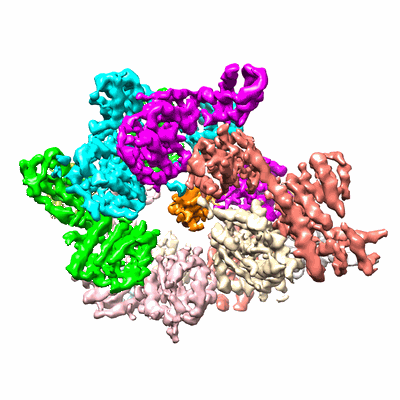EMD-21662
Cryo-EM map of semi-attached mutant OCCM-DNA complex (ORC-Cdc6-Cdt1-Mcm2-7 with Mcm6 WHD truncation)
EMD-21662
Single-particle4.3 Å
 Deposition: 05/04/2020
Deposition: 05/04/2020Map released: 15/07/2020
Last modified: 06/03/2024
Sample Organism:
Saccharomyces cerevisiae
Sample: ORC-Cdc6-Mcm3-Mcm7-dsDNA
Fitted models: 6wgc (Avg. Q-score: 0.301)
Deposition Authors: Yuan Z ,
Schneider S
,
Schneider S 
Sample: ORC-Cdc6-Mcm3-Mcm7-dsDNA
Fitted models: 6wgc (Avg. Q-score: 0.301)
Deposition Authors: Yuan Z
 ,
Schneider S
,
Schneider S 
Structural mechanism of helicase loading onto replication origin DNA by ORC-Cdc6.
Yuan Z  ,
Schneider S
,
Schneider S  ,
Dodd T
,
Dodd T  ,
Riera A,
Bai L
,
Riera A,
Bai L  ,
Yan C,
Magdalou I,
Ivanov I
,
Yan C,
Magdalou I,
Ivanov I  ,
Stillman B
,
Stillman B  ,
Li H
,
Li H  ,
Speck C
,
Speck C 
(2020) PNAS , 117 , 17747 - 17756
 ,
Schneider S
,
Schneider S  ,
Dodd T
,
Dodd T  ,
Riera A,
Bai L
,
Riera A,
Bai L  ,
Yan C,
Magdalou I,
Ivanov I
,
Yan C,
Magdalou I,
Ivanov I  ,
Stillman B
,
Stillman B  ,
Li H
,
Li H  ,
Speck C
,
Speck C 
(2020) PNAS , 117 , 17747 - 17756
Abstract:
DNA replication origins serve as sites of replicative helicase loading. In all eukaryotes, the six-subunit origin recognition complex (Orc1-6; ORC) recognizes the replication origin. During late M-phase of the cell-cycle, Cdc6 binds to ORC and the ORC-Cdc6 complex loads in a multistep reaction and, with the help of Cdt1, the core Mcm2-7 helicase onto DNA. A key intermediate is the ORC-Cdc6-Cdt1-Mcm2-7 (OCCM) complex in which DNA has been already inserted into the central channel of Mcm2-7. Until now, it has been unclear how the origin DNA is guided by ORC-Cdc6 and inserted into the Mcm2-7 hexamer. Here, we truncated the C-terminal winged-helix-domain (WHD) of Mcm6 to slow down the loading reaction, thereby capturing two loading intermediates prior to DNA insertion in budding yeast. In "semi-attached OCCM," the Mcm3 and Mcm7 WHDs latch onto ORC-Cdc6 while the main body of the Mcm2-7 hexamer is not connected. In "pre-insertion OCCM," the main body of Mcm2-7 docks onto ORC-Cdc6, and the origin DNA is bent and positioned adjacent to the open DNA entry gate, poised for insertion, at the Mcm2-Mcm5 interface. We used molecular simulations to reveal the dynamic transition from preloading conformers to the loaded conformers in which the loading of Mcm2-7 on DNA is complete and the DNA entry gate is fully closed. Our work provides multiple molecular insights into a key event of eukaryotic DNA replication.
DNA replication origins serve as sites of replicative helicase loading. In all eukaryotes, the six-subunit origin recognition complex (Orc1-6; ORC) recognizes the replication origin. During late M-phase of the cell-cycle, Cdc6 binds to ORC and the ORC-Cdc6 complex loads in a multistep reaction and, with the help of Cdt1, the core Mcm2-7 helicase onto DNA. A key intermediate is the ORC-Cdc6-Cdt1-Mcm2-7 (OCCM) complex in which DNA has been already inserted into the central channel of Mcm2-7. Until now, it has been unclear how the origin DNA is guided by ORC-Cdc6 and inserted into the Mcm2-7 hexamer. Here, we truncated the C-terminal winged-helix-domain (WHD) of Mcm6 to slow down the loading reaction, thereby capturing two loading intermediates prior to DNA insertion in budding yeast. In "semi-attached OCCM," the Mcm3 and Mcm7 WHDs latch onto ORC-Cdc6 while the main body of the Mcm2-7 hexamer is not connected. In "pre-insertion OCCM," the main body of Mcm2-7 docks onto ORC-Cdc6, and the origin DNA is bent and positioned adjacent to the open DNA entry gate, poised for insertion, at the Mcm2-Mcm5 interface. We used molecular simulations to reveal the dynamic transition from preloading conformers to the loaded conformers in which the loading of Mcm2-7 on DNA is complete and the DNA entry gate is fully closed. Our work provides multiple molecular insights into a key event of eukaryotic DNA replication.
